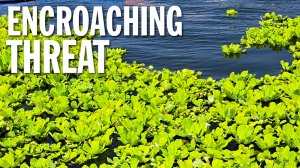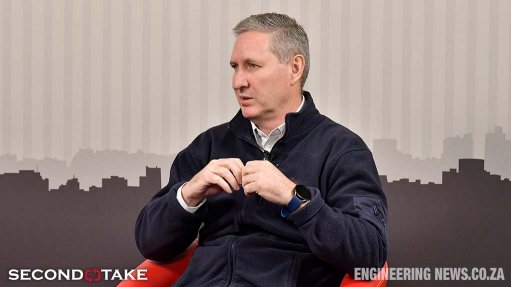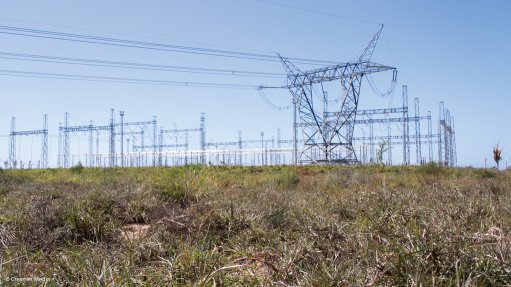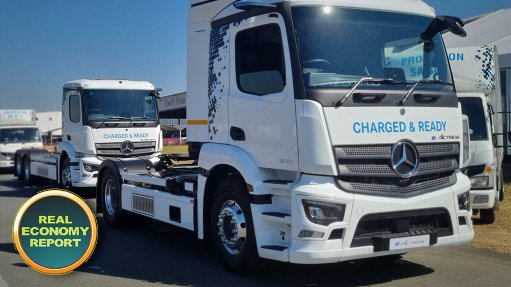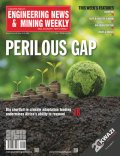Vaal Water Lettuce invasion signifies need to weed out water pollution
The Vaal Barrage is now home to an invasive plant species that has had significant negative economic and environmental consequences for the region, and its rapid spread will not slow down without intervention.
This has left the Department of Water and Sanitation (DWS), Rand Water and local communities, besides others, scrambling to get the species under control and mitigate the damage it is causing.
Speaking at a recent workshop on the integrated management of alien invasive species on the Vaal river, DWS water use compliance and enforcement chief director Anet Muir outlined how dramatic the spread has been.
Depicting the increase on a graph, she showed that water lettuce coverage of 3.52 ha was recorded on November 2, 2023. By January 21, 2023, following a period of stability, this had increased to 61.27 ha, before surging to 179.56 ha by February 10 this year.
A series of interventions, including chemical control, had reduced the alien species coverage to 163.68 ha by March 6. However, following a suspension of the use of chemical control pending further investigations, the infestation had increased to 193.66 ha by March 16.
By April, 240 ha, or 21%, of the Vaal Barrage’s surface area of 930 ha was covered by aquatic invasive alien species, including 7 km of upstream tributaries.
This is compared with the 5% hyacinth coverage at Hartbeespoort Dam, which also faced a major challenge over the past few years, although this is now under control, owing to work undertaken by Rhodes University and Magalies Water, the implementing agent.
Negative Impact
The impact of the prevalence of alien plant species on the environment and on the local economy has been significant.
Water and Sanitation Minister Senzo Mchunu said at the workshop that one of the key challenges is the management of alien invasive species, which can have a detrimental impact on the river ecosystem.
“These species, if left unchecked, can outcompete native vegetation, disrupt natural habitats and alter the flow of the river. This not only affects the biodiversity of the river, but also its ability to provide essential services such as clean water and flood regulation.”
The plants, which originate from South America, are floating aquatics that can be moved by wind or water movement and can multiply rapidly, and with the areas of the Barrage currently clogged, this presents a significant challenge for aquatic ecology, recreational activities and livelihoods.
“Water lettuce, in large infestations, can shade out the indigenous submerged aquatic plants, risking impacts on biodiversity,” adds Muir.
Water quality is further compromised, with a reduction in oxygen demand and eutrophication, which leads to toxic algal blooms and a further reduction in biodiversity.
The invasion is leading to the death of fish, particularly small and medium-sized species, under the water lettuce mats, while water birdlife has all but disappeared.
“The Vaal River is not just a vital water source; it is a lifeline for our communities, industries and ecosystems,” says Mchunu.
If access to the river is restricted, recreational activities will be affected, with two commercial boat operators and one house boat operator having closed their business and retrenched staff.
Hospitality establishments on the river are experiencing a decline in business, while real estate businesses and boat sales and servicing companies on the Vaal River Barrage face difficulties, Muir outlined in her presentation.
A Perfect Storm
Several factors have converged into a perfect storm that has led to the out-of-control expansion of water lettuce across the Vaal Barrage, including pollution, dysfunctional and noncompliant wastewater treatment works – as reported in the Blue and Green Drop reports – various environmental conditions, agricultural runoff and spray drift, informal settlements and industrial contaminants.
The rapid emergence of alien invasive species within the Vaal is indicative of a serious underlying pollution challenge, namely the acute and chronic discharge of contaminants into the Vaal River and its tributaries, infrastructure consulting firm AECOM South Africa senior environmental scientist Dr Anthony Mader tells Engineering News & Mining Weekly.
While it would be difficult to state with certainty, it is likely that a “significant series of events”, possibly storms and associated flooding events, triggered the extreme growth of the water lettuce owing to the release of large quantities of limiting nutrients, such as nitrogen and phosphorous, into the Vaal River system.
“From a historical perspective . . . the release of raw, partially treated sewage into the system has been going on for quite some time now. So, the question then is: Why has this not been an issue before?”
“This may point to a potential acute event, or a series of events, which has either increased the amount of overflow and subsequent discharge of additional raw or partially treated sewage and wastewater from wastewater treatment works or increased runoff from recently fertilised cultivated areas or fertiliser stockpiles, [besides others], causing a massive spike in nutrient introduction,” explains Mader.
Mader co-authored, alongside AECOM Africa Environment associate director Elisabeth Nortje and AECOM senior environmental scientist Tshuxekani Maluleke, commentary on whether the water lettuce is an invader or an indicator and unpacking the biogeochemical implications of the proliferation.
Taking Action
To get the invasion under control, a triple approach of chemical, removal and biological action is required.
The affected community and Rand Water engaged Rhodes University, which released weevils, as the biological agent, on the Barrage between September and November 2023, while community members physically removed the lettuce.
Rand Water, through the community, started with the chemical control on February 13 and 14 in conjunction with the biological control.
With the integration of the three control measures, the infestation can be brought under control within 18 months, after which biological control can contain any further infestations, Muir says.
If only biological and physical control are used, the process can take five years or more, while biological control on its own will take ten years.
While the chemical control reduced the hectarage invaded by the alien species, the earlier attempts at chemical spray were suspended, owing to public concern over the use of glyphosate-based herbicide spray and its impact on the environment and human health.
Muir explains that, at the time, the spray was registered only for use on hyacinth but not water lettuce.
Rand Water and the Department of Forestry, Fisheries and the Environment (DFFE) then engaged the registrar for guidance on an emergency registration, and ultimately received approval for Kilo Max 700 WSG for both water lettuce and hyacinth.
Muir explains that Kilo Max 700 WSG is a glyphosate sodium salt herbicide that does not contain the carcinogenic co-formulant polyethoxylated tallow amine, and there is a low risk to humans and a low potential for it to bioaccumulate in the human body, as 95% is excreted within 24 hours and completely excreted within 48 hours.
“Further, occupational exposure routes for herbicide sprayers and their exposure can be mitigated using the appropriate personal protection equipment and mitigation practises.”
The inhalation and dermal risks of Kilo Max are low and there is minimal risk of contamination or exposure to bystanders, residents and the public close to spray operations, she assures.
In addition, any risks are managed through application by appropriately qualified and registered operators and certified crop sprayers.
Following receipt of approval to use Kilo Max 700 WSG on water lettuce and hyacinth from the registrar, the team will start, upon chemical registration and update of general authorisation, with the chemical control component.
Rand Water also received a rearing permit from the DFFE on April 10 to grow its own weevils, to add to the volumes obtained from Rhodes University in Grahamstown, while five community members have volunteered to rear and look after the insects.
The water utility, under a water-use authorisation and guidance, will now continue with the integrated plan, and, in partnership with various stakeholders, is preparing not only for the current work planned but also work to be undertaken during this year’s spring season, when significant regrowth is anticipated.
Only a Short-Term Solution?
However, in the long term, action against poor-performing wastewater plants and pollution – the core source of the challenge – is required.
The demise of the water lettuce through chemical or biological means will assist in mitigating the problem; however, there is the risk of a “secondary” invasion, as there is still an underlying nutrient issue within the system.
Owing to their high nutrient assimilation capacity (phytoremediation potential), these plants have an elevated nutrient content.
Once killed, they sink to the bottom of the riverbed, where assimilated nutrients may be reintroduced back into the system as they decompose, contributing to the biogeochemical cycle of the accumulated nutrients and creating conditions, including light penetrating the water surface, conducive to the proliferation of cyanobacteria, or commonly, blue-green algae, which can be harmful to humans and animals, Mader comments.
“Although the control of the symptom, such as water lettuce, is vital, the primary focus should be addressing the sources of pollution, such as the dysfunctional wastewater treatment works, or putting together certain mitigation measures with regard to agricultural runoff to reduce the amount . . . of limiting nutrients from agricultural fields or stockpiles entering the tributaries.”
“While we are still scrambling for an effective solution, various multipurpose value-additions can be derived from the infestation. A study by Matache et al (2021) showed that water lettuce can be used in the creation of biofuel, fertilisers and compost, presenting an opportunity to promote socioeconomic development in the affected community.”
In response to the years-long decline in drinking water, as well as in wastewater and water-use efficiency, the DWS hosted a national two-day Water Services Authority Summit in January, where the performance of water services authorities was addressed at a high level.
“We engaged with municipalities, in their capacities as water services authorities, on the findings in the Blue, Green and No Drop reports. The Green Drop Progress Assessment Report indicated an increased risk in the performance of municipal wastewater treatment systems and poor performance in terms of effluent quality, with 67 municipalities having their wastewater systems classified as ‘critical’,” he explains.
Each water service authority was required to develop a comprehensive water and sanitation summit action plan to address the Drop results.
“Now, there are those municipalities that do not implement what is instructed in directives and notices issued by the department; these municipalities then leave us with no choice but to institute legal action,” the Minister warns.
“As key players in the water sector, we have a critical role to play in ensuring that the wastewater that is discharged does not create an enabling environment for these aliens,” says Mchunu.
Comments
Press Office
Announcements
What's On
Subscribe to improve your user experience...
Option 1 (equivalent of R125 a month):
Receive a weekly copy of Creamer Media's Engineering News & Mining Weekly magazine
(print copy for those in South Africa and e-magazine for those outside of South Africa)
Receive daily email newsletters
Access to full search results
Access archive of magazine back copies
Access to Projects in Progress
Access to ONE Research Report of your choice in PDF format
Option 2 (equivalent of R375 a month):
All benefits from Option 1
PLUS
Access to Creamer Media's Research Channel Africa for ALL Research Reports, in PDF format, on various industrial and mining sectors
including Electricity; Water; Energy Transition; Hydrogen; Roads, Rail and Ports; Coal; Gold; Platinum; Battery Metals; etc.
Already a subscriber?
Forgotten your password?
Receive weekly copy of Creamer Media's Engineering News & Mining Weekly magazine (print copy for those in South Africa and e-magazine for those outside of South Africa)
➕
Recieve daily email newsletters
➕
Access to full search results
➕
Access archive of magazine back copies
➕
Access to Projects in Progress
➕
Access to ONE Research Report of your choice in PDF format
RESEARCH CHANNEL AFRICA
R4500 (equivalent of R375 a month)
SUBSCRIBEAll benefits from Option 1
➕
Access to Creamer Media's Research Channel Africa for ALL Research Reports on various industrial and mining sectors, in PDF format, including on:
Electricity
➕
Water
➕
Energy Transition
➕
Hydrogen
➕
Roads, Rail and Ports
➕
Coal
➕
Gold
➕
Platinum
➕
Battery Metals
➕
etc.
Receive all benefits from Option 1 or Option 2 delivered to numerous people at your company
➕
Multiple User names and Passwords for simultaneous log-ins
➕
Intranet integration access to all in your organisation




